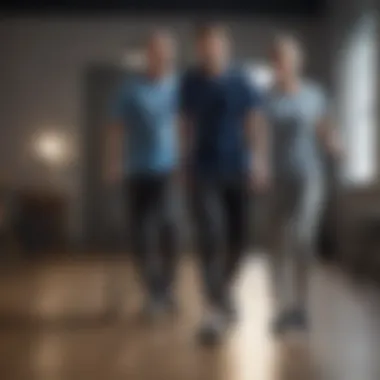Gait Exercises for Stroke Recovery: A Comprehensive Guide


Intro
Understanding the importance of gait exercises in the rehabilitation process for stroke patients is crucial. After a stroke, many individuals experience impaired mobility due to neurological damage. This often manifests as difficulty walking, balance issues, or general instability. Gait exercises aim to restore, improve, and maintain walking abilities, vital for regaining independence and enhancing overall quality of life.
This article will emphasize not only the physiological aspects of stroke-induced mobility issues but also the systematic implementation of various gait exercise strategies. Both healthcare professionals and caregivers play a pivotal role in this recovery process, with their guidance supporting the physical and psychological aspects of rehabilitation.
Furthermore, an evidence-based approach will be taken throughout this exploration, providing concrete methodologies and strategies that address the unique challenges faced by stroke survivors. Analyzing this field from multiple angles helps underlie the interconnectedness of physical mobility and mental resilience during recovery.
Key Findings
Major Results
Research indicates that consistent engagement in gait exercises can lead to significant improvements in walking speed and stability. Observational studies suggest that stroke patients who undertake a structured rehabilitation program, including specific gait training, display:
- Improved balance and coordination.
- Enhanced confidence during mobility activities.
- Reduced fear of falling.
Progress in these areas is not linear and may vary among individuals. However, the systematic practice of gait exercises contributes to more favorable recovery outcomes over time.
Discussion of Findings
The findings indicate enhanced mobility directly correlates with regular practice of gait exercises. Healthcare implementation varies, with individualized programs often showing the best results. Understanding that each stroke patient's experience is unique is paramount. Strategies must be adaptable to their specific needs, physical capabilities, and psychological states. For example, incorporating supportive tools such as walkers and parallel bars might facilitate more effective training sessions.
"Gait training not only aims to improve physical ability, but also fosters psychological well-being, crucial for holistic rehabilitation."
Regular assessments by healthcare professionals can motivate patients and help track progress. Such check-ins can refine exercise programs to maximize effectiveness.
Methodology
Research Design
Most studies in this field adopt a longitudinal research design. Collecting data over extended periods allows for observing changes in patient mobility and adjustments to exercise routines. This design is crucial for understanding outcomes and long-term impacts of gait exercises.
Data Collection Methods
Data collection often employs various methods:
- Surveys and questionnaires that assess patients' subjective experiences of mobility and confidence.
- Pre and post-exercise assessments to quantify improvements in walking speed and balance.
- Direct observational studies involving trained professionals monitoring patient exercises and progress.
These methods deepen the understanding of how gait exercises can yield positive changes in patients’ physical and psychological states.
Overall, this article aims to uncover and delineate effective gait exercise strategies for stroke rehabilitation, ensuring that both healthcare providers and caregivers are equipped with knowledge to support stroke survivors throughout their recovery journey.
For more information, consider visiting Wikipedia, Britannica or Reddit.
Intro to Gait Exercises
Gait exercises play a crucial role in the rehabilitation of stroke patients. These exercises focus on improving walking ability, which is often severely compromised after a stroke. Enhancing gait can significantly impact overall mobility and independence, leading to a better quality of life. This section provides an overview of why gait exercises are necessary for stroke recovery, addressing various benefits and critical considerations.
Overview of Gait and Its Importance
Gait refers to the manner of walking. It is essential as it affects how an individual moves within their environment. For stroke patients, regaining a normal gait is a primary goal during rehabilitation. Walking smoothly is not solely about putting one foot in front of the other; it involves coordination, balance, strength, and even cognitive functions.
When patients work on their gait, they engage different muscle groups and improve their neuromuscular connections. This integration of physical and mental efforts is vital, particularly after a brain injury such as a stroke. An effective gait increases mobility and fosters independence, which can lead to improved self-esteem and mental well-being. Thus, understanding how to assess and develop gait patterns in stroke patients is vital for healthcare providers.
Understanding Stroke and Its Effects on Mobility
A stroke occurs when blood flow to the brain is disrupted, leading to potential neuronal damage. This condition often results in various mobility challenges, including muscle weakness, coordination issues, and balance deficits. The severity and combination of these symptoms can vary significantly among individuals.
Stroke impacts motor control and the ability to execute movements smoothly. Many patients experience hemiplegia or hemiparesis, which affects one side of the body.
Key points to consider include:
- Physical Limitations: Patients may struggle with muscle stiffness or weakness. This can result in altered gait patterns that further complicate mobility.
- Cognitive and Perceptual Issues: Cognitive difficulties, often a consequence of stroke, can hinder a patient's ability to execute complex walking sequences.
- Emotional Consequences: The psychological effects, like anxiety or depression, can lead to decreased motivation. This lack of motivation impacts the willingness to engage in gait rehabilitation exercises.
Recognizing these challenges is pivotal in designing appropriate gait exercises that address the patient's unique requirements. An individualized approach is crucial for fostering improvements in mobility and overall rehabilitation outcomes.
"The right rehabilitation approach can restore mobility, improve quality of life, and enhance independence for stroke patients."
By understanding the intricacies of gait and the effects of a stroke, healthcare professionals can better tailor rehabilitation strategies, ensuring that patients are supported effectively throughout their recovery journey.
Physiological Changes After Stroke
Understanding the physiological changes that occur after a stroke is crucial for developing effective rehabilitation strategies. Stroke affects the brain, leading to a cascade of neurological and musculoskeletal alterations. Recognizing these changes helps clinicians tailor gait exercises to address specific deficits in mobility and strength.
Neurological Impacts
The neurological changes following a stroke are often profound. Brain damage can disrupt normal motor control and coordination. Many stroke survivors experience hemiparesis, which is weakness on one side of the body. This condition directly affects the ability to walk and maintain balance. Additionally, spasticity may develop, resulting in tightness of the muscles. Patients may find their movements to be less fluid, which complicates gait mechanics.
The brain's ability to rewire itself, known as neuroplasticity, plays a key role in recovery. This means that, with the right exercises and therapies, patients can regain some functionality. For instance,
- Engaging in repetitive gait training can encourage the brain to form new neural pathways.
- Lateral movements, such as side stepping, can help improve balance and coordination.
The connection between the brain and body is vital. Since a stroke can cause disconnection in these pathways, targeted exercises can facilitate reconnection, enabling improved movement patterns over time.


Musculoskeletal Alterations
Musculoskeletal changes are also significant after a stroke. The affected side of the body often suffers from muscle atrophy due to disuse. Over time, this change can lead to imbalances in the body.
Joint stiffness is common, impacting the range of motion. Such stiffness can create challenges when attempting to initiate walking or maintaining stability during gait. Patients may exhibit altered gait patterns, characterized by limping or dragging a foot.
Incorporating appropriate gait exercises addresses these adjustments. Some benefits include:
- Rebuilding muscle strength: Through weight-bearing and resistance exercises, patients can combat atrophy.
- Improving joint flexibility: Stretching routines can enhance range of motion over time.
- Realigning body mechanics: Training can help restore natural walking patterns, reducing the risk of falls.
"After a stroke, both neurological and musculoskeletal impacts must be addressed to maximize recovery outcomes. - Rehabilitation specialist"
Benefits of Gait Exercises in Rehabilitation
Gait exercises play an essential role in the rehabilitation of stroke patients. They contribute significantly to improving mobility, muscle strength, and psychological well-being. Understanding these benefits can help healthcare professionals tailor rehabilitation programs effectively.
Enhanced Mobility and Independence
Improving mobility is often the primary goal of rehabilitation after a stroke. Gait exercises are designed to help stroke patients regain their ability to walk with confidence and ease. Exercises that focus on walking patterns not only help improve gait but also assist in restoring balance and stability.
Increased mobility often leads to greater independence. As patients regain their abilities, they can perform daily activities without relying heavily on assistance. Simple actions, such as moving around the house or going for a walk, become achievable once again. This independence fosters a sense of accomplishment, which is crucial in the recovery process.
For example, practice of walking on different surfaces or navigating stairs can be included in gait training. By exposing patients to various challenges, they build not just strength but also resilience.
Improvement in Muscle Strength
Strength training is an important aspect of stroke rehabilitation. Gait exercises target specific muscle groups that are essential for walking. These exercises enhance the strength of the legs, core, and even the arms, providing a balanced approach to recovery.
Patients may engage in weight-bearing exercises, which help to rebuild muscle strength through resistance. For instance, practicing squats or leg raises can reinforce the muscles required for walking. This is vital not only for gait but also for preventing future injuries. When muscles are strong, the body is better equipped to support movement.
Furthermore, improved strength can lead to better endurance. Patients who can walk longer distances without fatigue will find it easier to return to their normal routines.
Contribution to Mental Well-Being
The psychological aspect of recovery cannot be overlooked. Gait exercises contribute to mental health in multiple ways. Engaging in physical activity releases endorphins, which are known to uplift mood and reduce feelings of anxiety.
As patients make progress, they experience increased self-esteem and confidence. The ability to move independently has profound effects on one’s mental outlook. It is important to recognize that each step forward in rehabilitation can bring not just physical benefits but emotional ones as well.
"The journey of recovery is often as much about the mind as it is about the body."
Additionally, the social aspect of rehabilitation emerges through group gait exercises. Participating in shared activities can foster connections among patients, helping them feel less isolated. Support systems become stronger, contributing positively to mental health.
Types of Gait Exercises for Stroke Patients
The selection of gait exercises for stroke patients is vital for enhancing their mobility and promoting recovery of movement. Specific exercises target different aspects of gait and movement, which can significantly influence the rehabilitation process. Understanding the types of exercises available allows healthcare professionals to tailor therapy for individual needs, ensuring the best possible outcomes.
Weight-Bearing Exercises
Weight-bearing exercises are crucial for stroke patients. These exercises require the individual to support their own body weight through their legs. Engaging in weight-bearing activities helps improve bone density, strengthens muscles, and enhances balance. Research indicates that these benefits are particularly important for individuals who have experienced a stroke, as they often face challenges with muscle weakness and mobility.
Some common weight-bearing exercises include:
- Standing on one leg
- Heel raises
- Step-ups
- Squats
In most cases, these exercises can be performed with assistance. It is essential to monitor the patient's ability and ensure a safe environment for practice. Weight-bearing exercises not only build strength but also encourage the muscle memory needed for better ambulation.
Balance and Coordination Activities
Balance and coordination activities focus on stabilizing the body while moving. These exercises can address issues caused by the stroke, such as diminished proprioception and muscle coordination. Improved balance is essential for stroke patients, as it supports safer ambulation and reduces the risk of falls.
Key balance and coordination activities include:
- Heel-to-toe walking
- Tandem standing
- Obstacle course navigation
- Use of balance boards
These activities challenge the body’s equilibrium and promote neuroplasticity, facilitating recovery. They can be adapted to different levels of ability, making them suitable for a wide range of patients.
Functional Gait Training Techniques
Functional gait training emphasizes real-life scenarios and aims to improve the patient's capacity to walk independently. This approach replicates tasks that are encountered in daily life, such as walking in a straight line, turning, and navigating through doorways or uneven surfaces. Such training not only supports physical recovery but also boosts the confidence of the patient.
Examples of functional gait training techniques involve:
- Simulated walking in community settings
- Task-specific training, such as carrying objects while walking
- Walking with varied surfaces, like grass or gravel
- Using platforms that mimic household environments
Implementing these techniques means providing patients with a more comprehensive skill set to negotiate their surroundings post-stroke.
Use of Assistive Devices
Assistive devices play a critical role in the rehabilitation of stroke patients. They provide support and enhance safety during gait exercises. Common assistive devices include canes, walkers, and crutches. These tools can help facilitate movement, easing the transition into independent walking.
The key considerations when using assistive devices are:
- Correct sizing and fit
- Ensuring proper usage techniques
- Regular assessment for any adjustments needed


Using assistive devices effectively can help rebuild the confidence of the patient and provide additional security. Eventually, many patients can progress towards less reliance on these aids as their strength and coordination improve.
Implementation Strategies for Gait Exercises
Implementing gait exercises effectively is crucial in the rehabilitation of stroke patients. The way these exercises are structured can significantly impact the recovery process and overall patient outcomes. First, the implementation strategies help in creating a personalized approach that targets the unique needs of each patient. This tailored method not only enhances the chances of success but also aids in maintaining patient motivation throughout the rehabilitation process.
Initial Assessment and Goal Setting
A thorough initial assessment is key to understanding the patient’s current mobility level. During this assessment, healthcare professionals evaluate various factors such as strength, balance, and coordination. This allows them to create specific and measurable goals for the exercises. Setting clear, achievable goals is essential as it gives the patient a sense of direction. Goals can include improving walking distance, increasing walking speed, or enhancing balance.
- Physical Examination: Evaluate muscle strength, tone, and spasticity in lower limbs.
- Functional Mobility Assessment: Determine the patient's ability to perform activities of daily living.
- Goal Type: Goals should be both short-term and long-term, focusing on independence in mobility.
Setting these goals collaboratively can motivate patients to engage more actively in their recovery.
Creating a Structured Exercise Program
Once the goals are established, creating a structured exercise program is the next step. This program should include a variety of gait exercises tailored to assist in achieving the identified goals. It's important to vary the types of exercises to prevent monotony and to address different aspects of gait.
- Weight-Bearing Activities: These are crucial for improving muscle strength and bone density. Exercises can include standing and stepping activities.
- Balance Training: Incorporate standing on one leg or using wobble boards to improve stability.
- Functional Tasks: Activities mimicking real-life situations, such as walking over obstacles, can help.
The program should be progressive, starting with simpler tasks and gradually increasing in complexity as the patient's abilities improve. Regular reviews of the program ensure it remains relevant to the patient's evolving needs.
Monitoring Progress and Adaptations
Monitoring progress is vital to ensure that the exercises are effective and to make any necessary adjustments. Regular follow-ups enable healthcare professionals to track improvements in mobility and modify the exercise regimen accordingly.
"Regular monitoring provides insights into a patient's recovery trajectory, allowing for timely interventions."
- Data Collection: Record changes in gait speed, endurance, and balance ability.
- Adaptation: Based on progress, modify exercises. For instance, increase difficulty as soon as the patient develops competence in current exercises.
- Feedback Mechanism: Encourage patients to share their experiences. Their feedback is invaluable in tailoring the program further.
These strategies provide a systematic approach to implementing gait exercises, contributing to effective rehabilitation. Following these structured guidelines assures that patients receive the support they need while working toward improved mobility.
Role of Healthcare Professionals
Healthcare professionals play a critical role in the rehabilitation of stroke patients, particularly in the implementation of gait exercises. Their expertise is essential for ensuring not only the physical recovery of patients but also their emotional and psychological well-being. A multidisciplinary approach that includes physical therapists, occupational therapists, nurses, and caregivers can optimize patient outcomes and streamline the recovery process.
Physical Therapists
Physical therapists hold a pivotal position in the rehabilitation process of stroke patients. Their primary focus is on the physical aspect of recovery. They design individualized gait training programs that consider the unique needs and limitations of each patient. By assessing factors such as strength, range of motion, and balance, these professionals create tailored exercise plans to facilitate movement re-learning.
Additionally, physical therapists educate patients about body mechanics and posture during walking. They employ various techniques, including increasing weight-bearing activities and balance training, to help restore mobility. Importantly, they also address physical security concerns, which allows for better confidence in movement.
Occupational Therapists
Occupational therapists complement the work of physical therapists by focusing on the daily functional aspects of life. They help patients regain the necessary skills for activities of daily living, such as personal care and meal preparation. Through specific gait exercises, occupational therapists target improving mobility within the context of these activities.
They incorporate functional tasks into rehabilitation. For instance, walking from a bed to a chair or navigating around obstacles mimics real-life challenges. This crossover enhances patient engagement by showing how exercises translate to everyday life. Furthermore, occupational therapists help patients utilize assistive devices, ensuring the adjustments to their environments are seamless.
Nurses and Caregivers
Nurses and caregivers often have the most frequent and sustained interactions with stroke patients. Their involvement is crucial for monitoring patient progress and adhering to the prescribed exercise regimens. These professionals provide not only physical support but also emotional encouragement, which significantly influences patient compliance with gait exercises.
Moreover, nurses are essential in managing the medication and health-related needs of stroke patients. They help manage pain and discomfort, which can otherwise hinder the commitment to rehabilitation. Caregivers, whether family members or professional aides, also play a vital role in providing daily support and motivation. Together, this team approach ensures holistic care and maximizes the chance of recovery.
"An interdisciplinary team fosters an environment where each patient's unique needs are addressed, enhancing the efficacy of rehabilitation efforts."
Psychological Factors in Recovery
Psychological factors play a crucial role in the recovery of stroke patients. Understanding how mental and emotional health intersect with physical rehabilitation can greatly influence outcomes. Patients recovering from strokes often experience a range of emotions, such as frustration, anxiety, and hopelessness. Being aware of these feelings allows healthcare providers to develop targeted strategies that can facilitate recovery.
Sizeable research indicates that motivation is a key element in patient recovery. When patients are psychologically engaged in their rehabilitation, they tend to participate more actively in their prescribed exercises. This engagement is essential for achieving meaningful progress in mobility and independence.
Several factors contribute to a patient’s psychological state, including their previous experiences, support systems, and understanding of their condition. It becomes important to assess these factors early in the rehabilitation process. By doing so, healthcare providers can tailor their approaches to meet the individual needs of each patient.
"Psychological well-being is as crucial as physical well-being in the rehabilitation of stroke patients."
Understanding Patient Motivation
In the context of rehabilitation, patient motivation is one of the most significant predictors of success. Motivated patients are more likely to adhere to rehabilitation protocols, engage in necessary exercises, and communicate their needs effectively with healthcare professionals. To foster motivation, it’s key to set realistic and achievable goals. This process often starts with small, measurable targets, allowing for gradual progression.
To understand motivation, healthcare providers can consider these aspects:
- Personal Goals: Identifying what is important to the patient can enhance their commitment toward rehabilitation. This can vary greatly between individuals. For example, one patient may wish to walk their dog, while another may aim to return to work.
- Positive Reinforcement: Recognizing and rewarding small achievements can bolster a patient’s desire to continue their recovery journey.
- Education: Educating patients about their condition and the rehabilitation process helps them understand the importance of their participation.
Addressing Emotional Challenges
Emotional challenges can impede the recovery process for stroke patients. Feelings of fear, anger, or sadness can lead to non-compliance with rehabilitation routines. Thus, addressing these emotional barriers is fundamental. Healthcare providers should encourage open communication about fears and concerns. Creating a supportive environment where patients feel safe to express their feelings can make a substantial difference.
Strategies to address emotional challenges include:
- Counseling: Engaging mental health professionals can aid patients dealing with significant emotional upheaval. Counseling can provide coping strategies and emotional support.
- Support Groups: Encouraging participation in support groups allows patients to share their experiences and feelings with others facing similar challenges, which can alleviate feelings of isolation.
- Mindfulness Practices: Practices such as mindfulness and relaxation techniques can reduce anxiety and improve emotional well-being, which in turn may support physical recovery.
By integrating psychological care into the rehabilitation process, healthcare professionals not only address the mental barriers faced by stroke patients but also enhance their overall rehabilitation experiences. This holistic approach ensures that patients are equipped emotionally and mentally alongside their physical recovery.


Case Studies and Evidence-Based Practices
Case studies play a crucial role in understanding the effectiveness of gait exercises in stroke rehabilitation. They provide real-world examples of how specific interventions can positively influence patient outcomes. Evidence-based practices, grounded in rigorous research, offer a framework for implementing these exercises in clinical settings. By analyzing successful rehabilitation programs, healthcare professionals can uncover valuable insights that enhance treatment protocols.
Successful Rehabilitation Programs
Successful rehabilitation programs often incorporate individualized gait training. These programs are designed based on the specific needs of each patient. For instance, a program may focus on basic weight-bearing exercises for individuals with significant mobility impairments, while another might emphasize more complex coordination tasks for those with improved capabilities.
Key components of these programs typically include:
- Assessment of patient abilities: A thorough evaluation helps tailor exercises to each patient’s physical and cognitive status.
- Integration of technology: Tools like treadmills with harnesses or robotic-assisted devices can help patients practice walking in a safe environment.
- Progressive challenge: Exercises gradually increase in difficulty to prevent plateaus in improvement.
One notable case is the use of body-weight support treadmills in clinical practices. Studies show that patients using such devices often exhibit faster improvements in walking speed and coordination compared to those receiving standard therapy.
Research Findings on Gait Improvements
Research offers compelling evidence supporting the effectiveness of specific gait exercises. Studies consistently report positive outcomes in enhancing mobility in stroke patients. For example, a systematic review published in Stroke Journal concluded that gait training significantly improves gait speed in post-stroke patients.
Other significant findings include:
- Increased walking endurance: Regular gait training sessions lead to improved endurance levels, allowing stroke survivors to participate in daily activities with less fatigue.
- Reduction in fall rates: Research indicates that systematic balance and gait training can lead to a decrease in fall incidents, providing a safer living environment for patients.
- Enhanced quality of life: Gait improvements contribute to greater independence and confidence among stroke survivors, leading to overall emotional well-being.
"Evidence-based practices in rehabilitation provide a clear path toward improving functional outcomes for stroke survivors. Each case study reinforces the notion that tailored interventions yield significant benefits."
Challenges in Implementing Gait Exercises
The implementation of gait exercises in stroke rehabilitation presents numerous challenges that can hinder the recovery process for many patients. Understanding these challenges is crucial for developing effective strategies that enhance patient outcomes. Addressing issues such as patient compliance and resource limitations can lead to more effective rehabilitation programs, ultimately improving mobility and independence for stroke survivors.
Patient Compliance Issues
One major obstacle in rehabilitation is ensuring that patients adhere to their prescribed gait exercise regimens. Compliance can be influenced by several factors, including physical limitations, psychological barriers, and lack of motivation. Many patients may experience fatigue or pain, which makes them less inclined to participate in exercises.
Additionally, psychological factors such as depression or anxiety after a stroke can significantly reduce a patient’s desire to engage in rehabilitation activities. It is important for healthcare professionals to establish a supportive environment that encourages patient participation. Strategies can involve:
- Setting achievable goals: This helps to foster a sense of accomplishment.
- Providing education: Clear understanding of the benefits of gait exercises may enhance motivation.
- Incorporating social support: Involving family and peers can strengthen adherence and emotional support.
"Patient involvement in their own rehabilitation process is pivotal; they must recognize the significant role they play in their recovery."
Resource Limitations in Care Settings
Another challenge arises from limitations in resources within care settings. Many rehabilitation facilities may not have adequate staffing, equipment, or space to fully implement comprehensive gait exercise programs. This can lead to insufficient time spent with each patient, reducing the effectiveness of rehabilitative efforts.
Key issues include:
- Staffing shortages: Less availability of trained professionals results in less personalized care for stroke patients.
- Limited equipment: Shortage of appropriate devices, like gait training machines or adaptive equipment, can restrict the types of exercises offered.
- Financial constraints: Budget limitations may prevent facilities from investing in advanced rehabilitation technologies or additional staff.
In summary, effectively addressing challenges related to patient compliance and resource limitations is essential for enhancing the success of gait exercises in stroke rehabilitation. Implementing targeted strategies can optimize therapy outcomes and empower stroke patients on their path to recovery.
Future Directions in Stroke Rehabilitation
The field of stroke rehabilitation is continually evolving. It remains critical to explore future directions in this area, especially regarding gait exercises. These exercises play a pivotal role in helping stroke patients regain mobility and independence. As research progresses, understanding the implications of innovative practices becomes essential for effective treatment strategies.
Innovations in Gait Training Technologies
New technologies have emerged that promise to refine gait training for stroke patients. Robotic-assisted therapy, for instance, is gaining attention for its ability to provide tailored gait training experiences. Devices like the EksoGT and Hokoma's Lokomat allow for precise adjustments based on a patient��’s progress, providing real-time feedback. These tools not only enhance the rehabilitation process but encourage patients to engage more actively in their recovery.
Additionally, virtual reality (VR) is making strides in this field. With VR systems, patients can practice walking in realistic environments. This technique offers significant benefits by replicating everyday challenges in a controlled manner. Using tasks such as crossing a street or navigating through crowds can improve confidence and reduce anxiety about mobility in the real world.
The integration of wearable technology also holds promise. Sensors can track gait patterns and provide data that informs therapists about the patient's progress. This information is crucial for adapting rehabilitation plans tailored to individual needs. The combination of these innovations significantly shifts the landscape of stroke rehabilitation.
Interdisciplinary Approaches
An effective rehabilitation strategy cannot rely solely on isolated practices. Therefore, interdisciplinary approaches are vital. Collaboration among physical therapists, occupational therapists, and speech therapists is imperative for comprehensive patient care. Each professional brings a unique perspective, allowing for a holistic view of the patient's needs.
For example, while a physical therapist focuses on gait improvements, an occupational therapist can address activities of daily living. They work together to create a personalized recovery plan that considers all facets of a patient’s life.
Moreover, interdisciplinary teams can utilize their combined expertise to tackle psychological aspects that affect recovery. Addressing emotional challenges is as paramount as enhancing physical abilities. Regular meetings among professionals ensure a cohesive plan and prompt adjustments based on the patient's evolving condition.
"An interdisciplinary approach enriches the context of care, promoting better outcomes for stroke survivors."
Finale
In this article, the significance of gait exercises for stroke patients has been thoroughly examined. The conclusion encapsulates vital elements that underline the importance of these exercises in the rehabilitation process.
Summarizing Key Points
The key points discussed throughout the article illustrate several notable benefits of gait exercises:
- Enhanced Mobility: Stroke survivors experience varied levels of physical impairment. Gait exercises help improve mobility, allowing greater independence in daily activities.
- Muscle Strength Improvement: Regular engagement in these exercises enhances muscle strength, crucial for restoring normal movement patterns.
- Mental Well-Being: Engaging in physical rehabilitation positively influences mental health. The sense of accomplishment from improved gait can uplift the spirits of many patients.
These elements showcase that gait exercises are not just physical activities; they contribute holistically to recovery and quality of life for stroke survivors.
The Importance of Ongoing Research
Continuing research is essential for multiple reasons. First, it leads to innovative therapeutic techniques that enhance gait rehabilitation. As new findings emerge, strategies can be refined to yield better outcomes for patients.
Furthermore, ongoing studies help in understanding the neurological and musculoskeletal changes post-stroke. Knowledge gained can inform healthcare professionals and caregivers on how best to assist patients.
Most importantly, research fosters collaboration among professionals from various disciplines. The integration of different knowledge bases can lead to more comprehensive care plans tailored to individual needs, thus boosting recovery processes.
In summary, ongoing research is not just beneficial; it is essential for evolving the field of stroke rehabilitation and improving patient lives.



